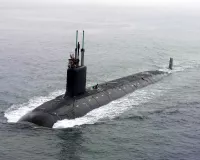Lorient Submarine Base, constructed in Lorient, France, by the German Kriegsmarine between 1941 and 1943, served as a significant U-boat base during World War II. Following Germany's defeat, the French Navy utilized the facility until its decommissioning in 1995. Subsequently, the base transitioned into civilian use, marking the end of its military function and the start of a new chapter in its history. Its construction and operation represent a key aspect of naval warfare during the war.
June 1940: Germany Seeks French Atlantic Ports
In June 1940, after the fall of France, Konteradmiral Karl Dönitz sought to use French Atlantic ports as forward bases for the German U-boat force.
November 1940: Construction Commences on Enclosed Pens
In November 1940, construction commenced on a series of enclosed pens with bomb-proof concrete roofs on the banks of the River Scorff, adjacent to the Lorient Arsenal.
February 1941: Construction Commences on K1 Installation
In February 1941, construction commenced on the K1 installation, which included a boat lift and rails to deliver U-boats to one of 5 enclosed bays.
December 1941: Completion of K2 Installation
In December 1941, the second set of protected bays, K2, were completed opposite K1.
1941: Construction by the German Kriegsmarine
In 1941, the Lorient Submarine Base was constructed by the German Kriegsmarine.
January 1943: Allied Bombing of Lorient Begins
In January 1943, Allied aircraft began bombing Lorient to cut supply lines to the U-boat bases.
February 1943: Allied Bombing of Lorient Continues
Between January and February 1943, Allied aircraft dropped hundreds of high-explosive bombs and thousands of incendiary bombs on Lorient, flattening nearly 90% of the city.
1943: Enlargement by the German Kriegsmarine
In 1943, the Lorient Submarine Base was further enlarged by the German Kriegsmarine.
1943: Construction Begins on KIVb and KIVa
In the summer of 1943, work began on a fourth phase of construction, a set of 6 pens (designated KIVb) alongside K1 and another six (KIVa) by K2, but little more than the foundations were completed.
June 1944: Normandy Landings
Following the Normandy landings in June 1944.
August 1944: Lorient Surrounded by Allies
On August 12, 1944, Lorient was surrounded by the Allies after the breakout. The remaining U-boats were evacuated, with the last, U-853, escaping for Norway on August 27.
September 1944: Execution of Jacques Stosskopf
In September 1944, Jacques Stosskopf, a hero of the French Resistance, was executed after his activities were discovered.
May 1945: German Surrender
In May 1945, Lorient, held by the German army, was surrendered to the American Army.
1945: France (1945–Present)
The entry indicates the end of the specified event occurred in 1945.
July 1946: Renamed Base Ingénieur Général Stosskopf
In July 1946, the base was renamed by the French as Base Ingénieur Général Stosskopf, commemorating Jacques Stosskopf.
1961: Launch of Flore Submarine
In 1961, the Flore, a Daphné-class submarine, was launched and is now featured in the Keroman submarine museum.
1997: Site Available for Civilian Use
After 1997, the Lorient Submarine base became available for civilian use, with the conversion of the pens into industrial units. Companies such as Plastimo moved in.
1997: Base in use until 1997
The base was in use until 1997, serving up to 10 submarines.
2000: Base Used by 2000 Personnel
The base was in use until 1997, serving up to 10 submarines, and in 2000 personnel were stationed.
Mentioned in this timeline

A submarine is a watercraft capable of independent operation underwater...
Germany officially the Federal Republic of Germany is a Western...
France officially the French Republic is a country primarily in...

September is the ninth month of the year in the...
A navy is a branch of a nation's armed forces...
Trending

12 days ago Yankees Offer Qualifying Contract to Trent Grisham: Center Field Plans Unveiled.
Chile-Peru relations have deep historical roots dating back to the Inca Empire Both entities share a border and maintained connections...

2 hours ago Cambridge Dictionary names 'parasocial' word of the year, inspired by Swifties and AI.

2 hours ago S&P 500 Plunges Amid Tech Slump and Economic Concerns, Dow Suffers 400-Point Drop
Ronald Reginald Van Stockum was a Brigadier General in the United States Marine Corps renowned for his distinguished military service...

Minka Kelly is an American actress known for her roles in both film and television She gained recognition for her...
Popular

XXXTentacion born Jahseh Dwayne Ricardo Onfroy was a controversial yet...

Cristiano Ronaldo often nicknamed CR is a Portuguese professional footballer...

Bernie Sanders is a prominent American politician currently serving as...

Chuck Schumer is the senior United States Senator from New...

Candace Owens is an American conservative political commentator and author...

Vivienne Westwood was a highly influential English fashion designer and...